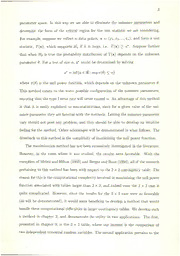Table Of ContentEXACTUNCONDITIONALINFERENCEFOR2x3AND2x2x2
CONTINGENCYTABLES
By
GERALDG.CRANS
ADISSERTATIONPRESENTEDTOTHEGRADUATESCHOOL
OFTHEUNIVERSITYOFFLORIDAINPARTIALFULFILLMENT
OFTHEREQUIREMENTSFORTHEDEGREEOF
DOCTOROFPHILOSOPHY
UNIVERSITYOFFLORIDA
1999
©Copyright1999
by
GeraldG.Crans
Tomyfather
ACKNOWLEDGEMENTS
IwouldliketoexpressmygratitudetoProfessorJonathanShusterforhisguidance
and patience throughout this dissertation. The workingenvironment was perfect
for me, and his suggestions and modifications were invaluable to this work. His
contributiontothisdissertationwascrucial.
IwouldalsoliketothankProfessorRandolphCarterforgivingmetheopportunity
toworkwithhisgroupasastatistician. Thejobhasbeenquiteinteresting,andthe
amountofpracticalstatisticalknowledgethatIhaveobtained, fromworkingwith
him,hasbeensubstantial.
MyappreciationextendstoProfessorsMalay GhoshandAndrew Rosalskyfor
readingthisdissertationandprovidinghelpfulsuggestions.
Finally, Iwould liketothankmyfatherforhisconfidenceandencouragement
throughoutmylife.
iv
TABLEOFCONTENTS
ACKNOWLEDGEMENTS iv
ABSTRACT vii
CHAPTERS
1 LITERATUREREVIEW 1
1.1 Introduction 1
1.2 AHistoryoftheMaximizationMethod 4
1.3 MotivationforanAlternativetoConditionalMethods 13
1.4 StatisticalPowerComparisons 14
2 MAXIMIZINGTHENULLPOWERFUNCTION 20
2.1 Introduction 20
2.2 FindingtheMaximumof}{B) 21
2.3 FindingtheMaximumofg(9) 26
3 THE2x3CONTINGENCYTABLE 30
3.1 Introduction — 30
3.2 TheConditionalApproachtothe2x3ContingencyTable — 32
3.3 DeterminingSampleSizesUsingtheConditionalApproach — 35
3.4 TheAsymptoticApproachtothe2x3ContingencyTable 42
3.5 AnExactUnconditionalTestforthe2x3ContingencyTable . 43
3.6 Results 47
4 THE2x2x2CONTINGENCYTABLE 51
4.1 Introduction 51
4.2 TheConditionalApproachtothe2x2x2ContingencyTable 53
4.3 DeterminingSampleSizeRequirementsUsingtheConditional
Approach 56
4.4 TheAsymptoticApproachtothe2x2x2ContingencyTable 63
4.5 AnExactUnconditionalTestforthe2x2x2ContingencyTable 65
4.6 Results 67
v
APPENDICES
A THESETf/3 69
B CHAPTER3TABLES 70
C CHAPTER3GRAPHS 78
D CHAPTER4TABLES 85
E CHAPTER4GRAPHS 94
F FORTRANPROGRAMS 105
REFERENCES 146
BIOGRAPHICALSKETCH 148
vi
AbstractofDissertationPresentedtotheGraduateSchool
oftheUniversityofFloridainPartialFulfillment
oftheRequirementsfortheDegreeof
DoctorofPhilosophy
EXACTUNCONDITIONALINFERENCEFOR2x3AND2x2x2
CONTINGENCYTABLES
By
GeraldG.Crans
May1999
Chairman: JonathanJ.Shuster
Majordepartment: Statistics
Exactunconditionalhypothesistestingmethodsinthecontextofthe2x2bino-
mialtrial,2x2multinomialtrial,andthecomparisonofcorrelatedproportionsex-
hibitasuperiorpoweradvantagewhencomparedwithexactconditionalapproaches.
However,untilnowtherehavebeennoattemptsmadetocompareunconditionaland
conditionalmethodsinamoreelaboratesetting, i.e. testingscenariosthatinvolve
morethanjustasinglenuisanceparameter. Thiswasduetotheunavailabilityof
techniquespresentforcomputingthemaximumofnullpowerfunctionsinvolvingsev-
eralnuisanceparameters.
Amethodologyisdevelopedhereinwhichprovidesameanstocomputethemax-
imumofnullpowerfunctionsthatareoftwopossibleforms. Thesetwoformscor-
respondtomultinomialandbinomiallikelihoods,whichcancontainseveralnuisance
parameters. Asspecialcases,the2x3contingencytabletocomparetwoindependent
trinomialdistributions,andthe2x2x2contingencytabletocompareindependent
proportionsattwodifferentstrataareconsidered.
vii
Fortheequalsamplesizecase,exactcriticalvaluesofthePearsonchi-squaretest
forcomparingtwoindependenttrinomialdistributionsarecomputedandtabulated
forn= 10(1)70, a = 0.025and a= 0.05. Tofacilitatecomparisons, atechnique
fordeterminingsamplesizerequirementswhenusingtheconditionalapproachwas
developed. For a = 0.025and apowerof0.80, samplesize requirements forthe
conditionaltestwereoftentimessmallerthanthosefortheexactunconditionalchi
squareand, infrequently, thesamplesizerequirementswerelarger. Graphsofthe
nullpowerfunctionsandthecomparisonofthecriticalregionssuggestthatthecon-
ditionalp-valueisabetterteststatisticthanPearson's.
Forthe2x2x2tableexactcriticalvaluesoftheMantelHaenszelteststatistic
withcontinuitycorrectionarecomputedandtabulatedforn=10(1)50,a=0.025
anda=0.05,wherethesamplesizenisthesameforeachbinomialtrial. Again,
amethodwasdevelopedtodeterminesamplesizerequirementsfortheconditional
approach,socomparisonscouldbemade. Fora—0.025andapowerof0.80,sample
sizerequirementsforeachmethodwereestablished. Theresultsprovedinconclusive,
asneithermethodoutperformedtheother. However,graphsofthenullpowerfunc-
tionsindicated that theconditional p-valueismuch morestablethanthe Mantel
Haenszelstatistic,andcomparisonsoftherespectivecriticalregionsindicatethatthe
conditionalp-valueisthebetterstatistic.
viii
CHAPTER 1
LITERATUREREVIEW
1.1 Introduction
Inhypothesistestingprocedureswhereboththenullandalternativehypotheses
aresimple,theoptimalsolutionforagivenlevelaiscompletelyspecifiedbytheNey-
manPearsonlemma. However,whenthedistributionoftheteststatistic,underH0,
dependsonadditionalparameterswearenotinterestedin,formallycallednuisance
parameters,thenthesolutionisanythingbutclear. Suppose,forexample,thatwe
areinterestedinconductingahypothesistestabouttheparameter9,butthedistri-
butionofthestatisticusedforthetestingprocedurealsodependsonthenuisance
parameter7. Theproblemwearefacedwithishowtoconductourhypothesistest
inthepresenceofthisunknownnuisanceparameter.
Therearenumeroussolutionstothenuisanceparameterproblem,andBasu(1977)
summarizesthese. Ofthemethodshereviews,onlythreewillbeconsideredinwhat
follows. Italsoshouldbenotedthatofthesethree,onlytwoareregularlyusedin
practice. Thefirst,andperhapsmostcommonmethod,isusingasymptotictheory.
Here, allparametersexceptthosebeingtestedarereplacedbyestimates. Inmost
casestheestimatesarethemaximumlikelihoodestimates,whichundercertainreg-
ularityconditionsareconsistent. Sincetheyareconsistent,wecanuselimittheory
resultssuchasSlutsky'stheorem(inconjunctionwiththecentrallimittheorem)to
derivetheasymptoticnulldistributionoftheteststatistic. Itfrequentlyturnsout
thattheresultingdistributionissimpleandwelltabulated. Asanexample,thePear-
sonchi-squareteststatisticforcomparingtwoindependentbinomialproportionshas
1
2
anasymptoticchi-squarenulldistributionwithonedegreeoffreedom. Theadvantage
ofusingasymptoticmethodsissimplicity. However,asthisisanasymptoticresult,
itmaynotworkwellforsmallsamples.
Thesecondmethodistheconditionalapproach. Sinceweoftenworkwithlikeli-
hoodsthataremembersofexponentialfamilies,wecanusethemethodsofLehmann
(1982)toeliminatenuisanceparameters. Forexample,supposeweareinterestedin
testingahypothesisconcerningtheparameter9inthepresenceofanunknownnui-
sanceparameter7. Also,supposethatXandYarerandomvariablesthatarejointly
sufficientfor(#,7),andthejointprobabilitydistributionof(X,Y)isamemberofan
exponentialfamily,i.e.
fxY{x,y;0,i)=C{6,-y)exp(tx(8)x+t2(y)y+g(x,y)).
Since7isunknown,wecanrestrictourclassofteststoa-similartests. Usingthe
conditionaldistributionofXgivenY,wecandevelopauniformlymostpowerfulun-
biased(UMPU)testforthehypothesisabout9. Themajorcriticismofthismethod
isthatifXandYarediscrete, theconditionaldistributionofX given Ywill be
discreteaswell, sothatarandomizationprocedureisneededtoobtainatestsize
ofexactlya. However,sincerandomizedtestsarenotusedinpractice,theresult-
ingnon-randomizedconditionaltestwillbeconservative. Anotherdisadvantageof
theconditionalmethodisthatwearerestrictedtoaconditionalsamplespace. All
statisticalinferenceprocedureswillbedonewithrespecttothisconditionalspace.
Thiswillposeaproblemtothenon-statisticians, inthattheinterpretationofthe
attainedsignificancelevel (p-value) isnolongerappealing, orforthatmattereas-
ilyunderstandable. Whenconditional methodsareusedintheapplied literature,
suchasmedicineoragriculture,theconditionalnatureofthep-valueisalmostnever
mentionedinthepublication.
The third technique is the maximization method. Here, the size ofa test is
determinedbymaximizingthenullpowerfunctionoverthedomainofthenuisance

